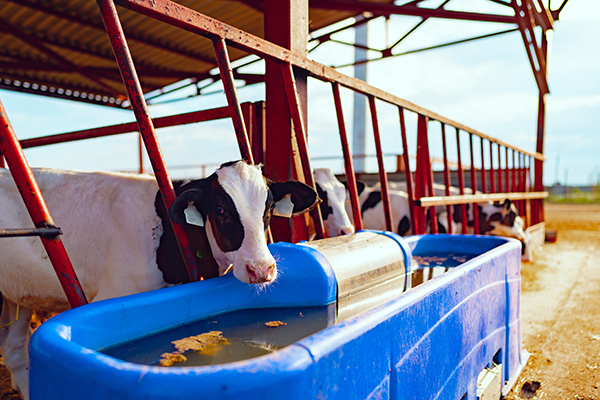Optimizing Water Systems for Herd Health and Efficiency

By Jaclyn Krymowski
Water is often billed as “the most important nutrient.” Perhaps this statement is a bit of an oversimplification because access to water alone is not enough, especially for lactating cows. Providing water that is also clean, readily available and, in some cases, compatible with regional laws or conservancy regulations, can be a bit more complex.
Beyond drinking, water plays a crucial role in dairy management. Fresh water should be available after milkings to encourage cows to stay on their feet while their teat ends close, reducing the risk of infection. Factors like weather, temperature, and overall barn environment impact water consumption.
Beyond the cows, water is also used for essential farm tasks, from footbaths to flushing alleyways, making an efficient water system critical to daily operations.
Types of Water Systems
There are various systems available for supplying cattle with water, from water bowls to larger water tanks. There are several considerations for determining what is best for your operation whether you need to reach animals in the barn, dry lot or pasture.
General recommendations include two to four inches of perimeter space per cow, with a tank height of 24 to 32 inches and a water depth should be at least three inches. Additionally, there should be at least two water locations per pen or a number that allows 20% of the cows in a group to drink at once, according to the Penn State bulletin The Value of Water by Carly Becker, former dairy extension educator.
“(A) water tank located within 50 feet of the feed bunk or at every crossover in a freestall barn and water should be immediately accessible after returning from milking,” she writes.
Placing waterers where cows can drink while eating can help increase dry matter intake and milk production. If waterers are positioned away from the feed area, they should be no more than 15 to 20 stalls—or about 50 feet—from the cows’ access points. Alley width is another important factor when selecting a location for a water tank. There should be sufficient space to accommodate the tank, the length of a cow while drinking, and enough room for one- or two-way traffic to pass comfortably.
Caring for Water Systems
Cleanliness and flow rate are two of the keys to keep cows drinking year round.
“Cows will drink 30% to 50% of their total daily water intake within one hour or so after milking, writes Becker. “This time is also a peak period for cleaning milking equipment; therefore, water flow going to the waterers may decrease. Water flow rates should be observed at these heavy use times and altered accordingly.”
The specifics of your region and water source will all come to play direct roles in how much upkeep your system needs. Natural water systems versus water supply coming from a well or aquifer can impact quality of water and the additional treatment required in addition to availability.
Remember that water management also includes handling waste water. For many dairies, it is both economically valuable and environmentally responsible to repurpose it and have a sustainable system. Farms in all different scenarios can be intentional with repurposing their waste water for flushing alleys or even for watering.
In the winter or cold weather additional care may be required. Add heaters and ensure they are installed properly or break ice regularly so water is available as much as possible.
Maintenance
Like any mechanical system, waterers and water systems require regular maintenance to ensure they function properly. Having a proactive service or maintenance program in place can help prevent costly repairs and downtime. Addressing small issues early often saves both time and money in the long run. Below are some of the basics you’ll want to keep covered, but remember to adjust according to the season and needs of your specific region.
Preventing Leaks and Water Waste
Unchecked leaks can lead to excessive water usage and, depending on the setup, create soggy bedding that impacts cow comfort and hygiene. Regular inspections help catch leaks early, reducing waste and preventing unnecessary messes in the barn.
Winter Preparedness and Pump Maintenance
Pumps must function year-round, especially during freezing temperatures. A failed pump in subzero conditions can quickly turn into a major challenge. Regular maintenance ensures pumps remain operational, minimizing the risk of unexpected breakdowns in extreme weather. If winters are particularly mild in your region, you should still make it a habit to check pumps, gaskets, floats and valves at least annually.
Water Quality Monitoring
Understanding the general water quality in your area is essential, but routine testing adds an extra layer of assurance. Regular water analysis can help detect imbalances or contaminants that might otherwise go unnoticed. High levels of elements like iron and sulfur can not only affect the performance of water systems—causing buildup and clogging—but may also impact herd health by altering water palatability and interfering with nutrient absorption.
Always stay informed about any local water advisories or contamination reports. Nearby agricultural runoff, industrial activity, or even natural events can introduce harmful bacteria or chemicals into the water supply, making vigilance crucial for maintaining a safe and reliable water source for your herd.
Pipe and Line Maintenance
Maintaining water lines and pipes is critical to preventing leaks, particularly overhead leaks that can develop into weak points over time. This is especially important for any water sources related to your parlor, milkhouse and milk cooling. In winter, compromised pipes are especially vulnerable to freezing and bursting, making preventative care essential for a reliable water system.
Water plays a crucial role in dairy operations, whether for drinking, parlor and milkhouse cleaning, or maintaining equipment. A well-maintained water system will both ensure an adequate supply while preventing emergency repairs and costly downtime. Regular maintenance keeps operations running smoothly and supports overall herd health.

